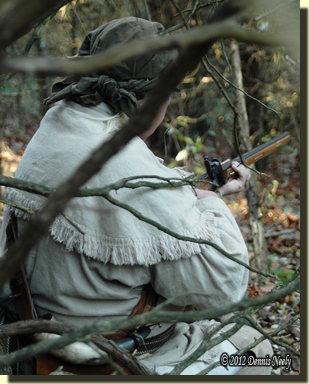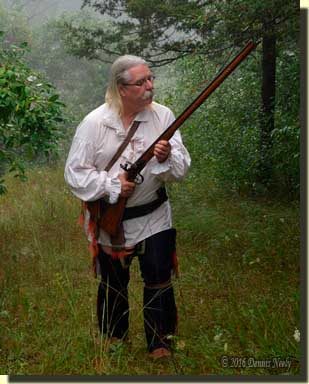Ten paces grew to thirty. Cedar tree after cedar tree met rejection. A wild turkey scratching bowl came into view, ahead, to the right of the earthen doe trail. “Three, maybe four days old,” the post hunter muttered in a gravely whisper. White-tipped droppings, not a lot just a few, all curled on one end, lay scattered about. “Gobblers,” the woodsman nodded…again, to no one.
A circular search, executed with the stealth of a stalk on a fine buck, found three more torn up locations, each with the distinct toenail marks of a purple-legged bronze beauty. A dead apple tree stood twenty paces distant. Limbs stretched wide, all devoid of foliage or even tiny twigs bearing some hint of life. Elk moccasins investigated the barren lair, certain of rejection, too.
Now a ways beyond the apple’s drip line two hefty red cedar trees grew straight and tall. A third cedar of the same size, tipped earthward by some calamity, angled on the uphill side of those two. Prospects seemed good. Autumn olive bushes with yellowing, fish-like leaves dotted the ground all about, adding cover, but limiting clear-shot possibilities.
At a prospective spot, the woodsman dropped to a leather-clad knee and gazed about. Bare fingers dusted away duff until a sharp spine suggested an alternative. Standing in disgust, the hunter’s left moccasin soon completed the task. The red-wool trade blanket, rolled tight and bound with the tails of a leather portage collar, settled into the nest.
After an appropriate wait, the single wing-bone call touched the forest tenant’s dry lips. “Ark, ark,” two clucks, soft and sweet, beckoned through the cedar trees. Five minutes later…“Ark, ark.”

“Ark, ark,” came the answer, bold and crisp, uphill to the east. The Northwest trade gun’s muzzle crept in the direction of that utterance. The forestock rested on the leather leggin of the left knee, raised and ready. Arteries pulsed. The death bees waited. Those same dry lips mouthed an almost overlooked prayer: “A clean kill, or a clean miss. Your will, O Lord.”
“Scu-reeeeee…Scu-reeeeee!” To the west of the cedar grove, somewhere out over the expanse of the big swamp, a red-tailed hawk circled, unseen but not unheard. About then, a hint of black herky-jerked through a break in the autumn olive sprigs. The bird pecked along, looking side to side, stopping to sample, then continuing on with no concern. Another appeared, then another, all well beyond “Old Turkey Feather’s” effective distance.
The first wild turkey edged to its left at forty paces, but that adjustment would not help. A modest beard with a slight downward curve came into view. More birds fed their way down the hill, all lacking the curiosity needed to investigate the hired hunter’s four clucks. The birds’ contented manner never wavered, pecking, inspecting and once in a while stretching a neck to look about for danger. Frustrating…Oh so frustrating…
Clearing my head…
On that late-October morning, in the Year of our Lord, 1796, wild turkey sign, coupled with a careful assessment of the surrounding natural cover increased the probability of besting a fowl. But the flock did not wander within the effective distance of a Northwest gun called “Old Turkey Feathers.” All the wishing didn’t change that fact. Sometimes the glade is a cruel tormentor.
Most living historians share a keen sense of responsibility for getting their given portrayal as close as possible to the available documentation from their favorite bygone era. Unfortunately any historical simulation, especially those that center on traditional black powder hunting, can only approach what life was really like in the 18th century. Generations have come and gone on the North-Forty. The River Raisin has changed course, who knows how many times. The Old Northwest Territory is no more.
As I transcribed that fall wild turkey chase from my journal notes, I re-lived the moments. I heard the hen’s “Ark, ark” and the red-tailed hawk’s “Scu-reeeeee…Scu-reeeeee!” I recalled pulling up my left leg, resting my elbow and swinging the muzzle with a flood of hopeful anticipation. Ah, yes…the first glimpse of a bronze beauty, played out in my mind’s eye like a slow-motion instant replay of a NASCAR bumping.
I pounded the keyboard. My pulse grew stronger—despite knowing the outcome of that encounter, too. And when the words reached the conclusion of that foray, my shoulders sank in an empathetic pity puddle of frustration.
Now, dear reader, please keep in mind that I often select a 1790-era journal entry at random. That was what I did on Monday. I did not consciously pick a frustrating incident. It just happened.
Much to my consternation, when the vignette ended the frustration I felt for that moment unleased the frustrations and emotions of this troubled time we live in. I was sputtering, typing like mad, venting at…well, you understand, I’m sure. I left the desk in desperation, mad at the world, then mad at myself, because I didn’t want to read someone’s rant, so why would you?
Then the reality of “moving on” set in just as it did that afternoon. Life went on in 18th-century America, or New France, depending upon who I am on any given living history adventure. I waited on the birds, making sure there was no chance of detection when I finally got to my feet. That gave me time to think, to reason out my next attempt at bringing food back to camp that evening.
It seems this year’s gobblers are sneakier than last. Why not? That said I’ve had a ball in the turkey woods this spring. Since late April, frustrating jaunts—oh, there’s that word again—have turned into great delights, bringing new insight into my traditional black powder hunts.
The focus of what little hunting I was able to squeeze in last fall centered on re-evaluating each characterization. To get those portrayals off and moving, I used “historical hand-me downs.”
The goal was always the same: make each character unique and different, each with his own backstory, life experience and material possessions. About two years ago, when Mi-ki-naak entered the picture, I began crafting or purchasing separate accoutrements and clothing items that “belonged” to a specific alter ego.

That process got put on hold, but I stumbled my way back on track earlier this year. I am moving on, slow but sure. The cedar log pile, destined for the post hunter’s lean-to, is growing. My thoughts on where to place the shelter are changing, but I’m big on overthinking the obvious.
A forum post on shot pouches led to a telephone conversation. In the midst of quoting documentation and hashing over the comments, I pulled up my outline of James Smith’s captive narrative, Scoouwa. I searched the word “pouch.” For purposes of our discussion, I was interested in Smith’s deerskin pouch, which contained his books.
But the search also found his reference to the “polecat skin pouch, which had been skinned pocket fashion…” (Smith, 30). That pouch had slipped my mind, but offered a solution for carrying Mi-ki-naak’s flint and steel and whatever form of journal keeping I settle on for his persona—he can’t keep borrowing the post hunter’s journal. After researching several similar pouches in museum collections, a case-skinned skunk is on its way. Polecats are not native to this area, but Sir Johnathan Caldwell’s painting shows a skunk-skin pouch. I am moving on…
The same held true with looking at knives. Samuel the Trader’s hired hunter started out with a butcher knife. I couldn’t begin to count the number of deer that knife has dressed and skinned—but it is one of those “shared” artifacts. Well, he gets to keep his knife.
I purchased an English scalper reproduction, not an expensive one mind you, but one that came with high recommendations. I re-worked the handle to match an original I had photos of. Msko-waagosh was thrilled with that knife. I was about to begin an Ojibwe-style sheath, but then the unthinkable happened—the knife would not skin a buck. After all that work, the knife won’t hold an edge.
A package arrived Monday with two new knives forged by Nick Barber. One is an English scalper of a similar pattern as the old one for Msko-waagosh, the other a French boucheron for Mi-ki-naak. Individual sheaths, both showing an Ojibwe or Odawa influence are the next project. In a short while, each of my alter egos will have his own personal knife. No more sharing, no more bickering.
The post hunter wore out his knee breeches two years ago. The patches were threadbare; there was no saving them. In essence, this nameless hired woodsman has no lower-body covering; to complicate matters, that character is not a breechclout kinda guy.
I dug out the new pair the week before the Woods-N-Water News Outdoor Weekend in September, held at the Eastern Michigan Fairgrounds in Imlay City. That was to be my demonstration project for the event. A trip to the local emergency room ended that. I unpacked those breeches yesterday and hope to get the last of the buttons and buttonholes stitched up in the next few nights. The post hunter wants to venture back to yesteryear, too.
So this week’s message is the same as it was that afternoon in 1796: accept the frustrations of life and keep moving on to the next time-traveling adventure…
Give traditional black powder hunting a try, be safe and may God bless you.


